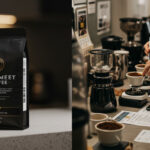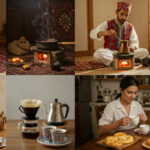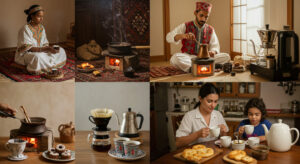
How Is Gourmet Coffee Evaluated? Discover the Classification Criteria

Table of Contents
ToggleOrigin and Quality of the Beans
Gourmet coffee begins with the selection of high-quality beans sourced from regions known for their excellent production. Specialty beans, such as Arabica varieties, are highly valued for their refined flavor and lower caffeine content. Factors like altitude, climate, and soil directly influence the coffee’s sensory characteristics. Traceability is also essential, ensuring transparency and authenticity of the product.
Cultivation and Harvesting Processes
Producing gourmet coffee requires special care. Sustainable practices such as organic farming and preserving the local ecosystem are key elements. Harvesting is often done manually, focusing on ripe cherries to ensure greater consistency and quality. This step is crucial, as unripe or overripe beans can negatively affect the final taste. Careful selection is the first step toward high-quality coffee.
Roasting and Brewing Methods
Roasting is one of the most critical stages in gourmet coffee production. It must be performed with precision, respecting the sensory profile of each batch. A balanced roast enhances flavor notes like fruits, chocolate, nuts, or even spices, depending on the origin. Brewing methods such as drip, espresso, or French press also impact the final result, each offering a unique experience that highlights different aspects of the coffee’s taste and texture.
Key Evaluation Criteria
Aroma: Identifying Sensory Nuances
Aroma is the first impression and a key factor in the sensory experience. It reveals a lot about the bean’s origin, roasting process, and quality. Aromas can include citrus fruits, floral notes, spices, or earthy tones. High-quality gourmet coffee usually has a complex and inviting aroma that entices you to take the first sip.
Flavor: Balance, Sweetness, Acidity, and Body
Flavor is the heart of coffee evaluation. It includes several elements that must work in harmony. Balance is essential—no characteristic should overpower the others. Natural sweetness (not added sugar), balanced acidity that adds brightness, and the body (mouthfeel) are all vital. The body can range from light to full, contributing to the overall experience.
Finish: Duration and Quality of Aftertaste
The finish or aftertaste is what remains in the mouth after sipping. A great gourmet coffee typically leaves a pleasant, lasting impression, echoing the flavors noticed during tasting. The length and quality of the aftertaste indicate the coffee’s complexity and balance. A short or unpleasant finish may suggest flaws in the production or roasting process.
The Importance of Scoring in Specialty Coffee
SCA Scoring System
Specialty coffee is evaluated using strict parameters, and the Specialty Coffee Association (SCA) is one of the leading organizations setting these standards. The scale ranges from 0 to 100 points, and only coffees scoring 80 points or higher are classified as specialty. The score considers various aspects, such as:
- Aroma: Presence and complexity of perceived aromas
- Flavors: Sensory notes like fruity, floral, chocolatey, etc.
- Acidity: The brightness and liveliness it adds
- Body: Mouthfeel and texture
- Finish: Duration and quality of the aftertaste
- Uniformity: Consistency across multiple cups
- Absence of Defects: No broken, fermented, or impure beans
How Scoring Impacts Value and Reputation
The SCA score reflects the exceptional quality of the coffee and directly affects its market value and reputation. Coffees scoring above 90 points are considered rare and premium, often winning awards and international recognition. This drives producers to improve every step—from cultivation to roasting—to achieve top scores.
For consumers, understanding the scale helps in appreciating and choosing coffees that match their preferences. For professionals like baristas and café owners, the score serves as a guide to select coffees that elevate their brand and surprise their clients.
Consistently high scores build trust and desirability, making those coffees synonymous with memorable sensory experiences.
Professional Tasting: The Role of the Q Grader
Training and Certification of Coffee Evaluators
To become a Q Grader, professionals undergo rigorous training and certification through the Coffee Quality Institute (CQI). This process covers sensory analysis, roasting, and brewing techniques. Candidates are tested both practically and theoretically on aroma, flavor, acidity, body, and finish.
Key modules include:
- Identifying aromas and flavors
- Detecting defects in green and roasted coffee
- Sensory grading following international standards
- Triangulation testing (differentiating similar coffees)
This challenging journey ensures accurate and consistent evaluation of specialty coffees.
How a Professional Cupping Session Works
A cupping is a standardized tasting session designed to evaluate coffee quality objectively. It involves:
- Sample preparation: Coffee is ground and placed in specific cupping cups, with water-to-coffee ratios measured precisely.
- Aroma evaluation: Before water is added, evaluators smell the dry grounds; after brewing, aroma is assessed again.
- Tasting: Using a cupping spoon, evaluators taste the coffee, noting sweetness, acidity, body, and balance.
- Scoring: Each attribute is scored to determine the final quality rating.
Cupping helps identify strengths and areas for improvement in cultivation, processing, and roasting.
Tips to Evaluate Coffee at Home
How to Train Your Palate
Developing your palate takes attention and practice. Try coffees from different regions and brewing methods, focusing on aroma, acidity, sweetness, and body. Taste slowly and let the coffee spread across your mouth to notice subtle differences. Compare side-by-side and note what stands out in each cup.
Essential Equipment for Proper Tasting
To recreate a professional tasting at home, consider:
- Proper cups: Glass or porcelain preserve heat and don’t affect flavor.
- Cupping spoon: Wide and shallow spoons help slurp and aerate coffee.
- Filtered water: Essential for a clean-tasting brew.
- Coffee grinder: Fresh grinding ensures optimal flavor extraction.
Taking Notes and Comparing Coffees
Keep a tasting log to track your discoveries and palate development. Note:
- Aroma: floral, fruity, earthy, etc.
- Flavor: chocolate, citrus, nutty, etc.
- Acidity: bright, smooth, bold.
- Body: light, medium, full.
- Finish: long, clean, lingering.
Regular comparisons help sharpen your senses and define your taste preferences.
The Gourmet Coffee Market and Its Trends
Growing Demand for Specialty Coffee
The gourmet coffee market has grown rapidly, driven by increasing interest in specialty coffees. Consumers are looking for quality, traceability, and unique flavor experiences, often willing to pay more for standout cups.
The Impact of Sustainability in Production
Sustainability is now a core value in gourmet coffee production. Practices like organic farming, water conservation, and soil care improve both the environment and bean quality. Conscious consumers support ethical brands, creating a positive feedback loop between demand and responsible production.
Innovations in Roasting and Brewing
Technology has brought advanced methods to roasting and brewing. Techniques like temperature-controlled roasting and cold brew infusions allow deeper exploration of flavors. These methods empower baristas and enthusiasts to push the boundaries of specialty coffee.
How to Choose the Ideal Gourmet Coffee
Identifying Your Preferred Flavor Profile
Start by understanding your palate. Do you enjoy fruity and acidic notes (like Ethiopian beans) or chocolatey, full-bodied flavors (like Brazilian beans)? Try different origins and jot down your thoughts to discover your favorite profile.
Comparing Brands and Origins
Origin plays a crucial role in flavor. For example:
- Central America: Bright acidity and citrus notes
- Africa: Fruity, floral, complex flavors
- South America: Balanced, with chocolate and nutty undertones
Research reputable brands known for transparency and quality, and read expert reviews to find hidden gems.
Trying Different Brewing Methods
Brewing methods significantly alter the experience. Explore various techniques to find what best suits your taste:
- French Press: Full-bodied, rich
- Pour Over: Clean and bright
- Espresso: Intense and creamy
Experimenting with methods reveals new dimensions of the same coffee.
Conclusion
Choosing the perfect gourmet coffee is a journey of self-discovery and experimentation. By identifying your flavor preferences, exploring origins and brands, and testing brewing methods, you can find your ideal cup. There’s no right or wrong—only what pleases your palate. So enjoy the process and dive into the world of gourmet coffee!
Frequently Asked Questions (FAQ)
1. What makes coffee “gourmet”?
Gourmet coffee is defined by high-quality beans, careful production, and a superior flavor profile. It often scores 80+ on the SCA scale.
2. What’s the difference between Arabica and Robusta?
Arabica is smoother, sweeter, and more aromatic. Robusta is bolder and higher in caffeine but generally considered less refined.
3. Can I evaluate coffee at home?
Yes! With the right tools and attention to flavor, you can develop your palate and enjoy the process of discovering your favorite coffee.
4. How do I store gourmet coffee?
Use an airtight container in a cool, dark place. Whole beans stay fresher longer—grind just before brewing.
5. Which method best preserves flavor?
It depends on your preference. Pour Over is ideal for clarity, French Press for body, and Espresso for intensity.
6. Is organic coffee always gourmet?
No. While organic methods are great for sustainability, gourmet status also depends on taste, processing, and scoring.
is a writer and editor at Coffee With Finance, blending her love for coffee, personal finance, and visual storytelling. She crafts engaging articles, curates site images, and shares brewing tips, bean origins, and practical money advice. Anna believes that managing finances, like making great coffee, should be intentional and rewarding — bringing clarity, warmth, and beauty to every story she tells.




























Post Comment